
Hereke rugs are among the most coveted collectibles; they are beautiful and expensive; and as any objet of great aesthetic value, imitable.
Hereke is a town that is not too far from Istanbul. It was the Otttomn Emperor Sultan Abdulmecid (1823-1861) who set up the original carpet factory in Hereke in 1843.

It is said that only the best artists were brought here from the Persian city of Kerman to share their skill and talent and produce the finest carpets for the imperial palaces in the region.
Soon after the collapse of the Ottoman Empire, a state-run school of carpet making was established within the premises of the old Hereke Imperial Factory.
A number of reputable workshops sprang out in the town en suite ensuring a steady supply of the finest silk rugs to the markets around the world.
Small-format silk rugs with knot counts in excess of a million per a single square meter have become very popular among collectors and nearly a household name in home décor in the Western World .
The demand was high and so were the prices, a situation which inevitably gave rise to sub-industries.
Keyseri, a town in central Turkey, still produces well-made and rather inexpensive imitations of Hereke Ottoman designs in mercerised cotton.
China, of late, began producing extremely fine, high quality copies of the same designs which ironically (owing precisely to the astounding quality) have become collectible too; they are classified officially as Chinese Herekes.
And of course, there are forgeries meant to capitalize of the high value and popularity of the genuine rugs and deceive unsuspecting buyers.
There are however several unique features to the silk rugs from Hereke which are distinguishable enough to spare even an inexperienced buyer a substantial financial loss.
Hereke versus Keyseri
- Most Hereke rugs are signed; Keyseri rugs almost never.
- Most Hereke rugs feature abstract arabesque patterns; Keyseri rugs often feature realistic avian motifs.
- All Hereke rugs are made of expensive natural silk; Keyseri rugs are made of inexpensive artificial silk which is actually mercerised cotton.
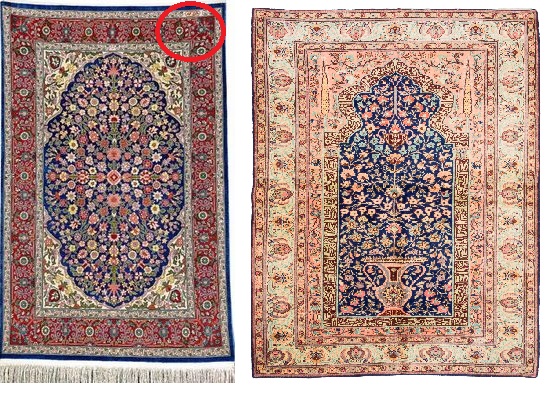
Turkish versus Chinese Hereke
- Most Turkish Herekes are signed; the signature typically, but not always, appears in the top right corner.
- Most Chinese Herekes are signed HEREKE – هرك (the same genuine signature) but the cartouche-like trade mark tends to appear on the kilim part of the silk rug as opposed to the pile part as is the case with genuine Turkish Herekes. Herekes from a very reptable Ozipek workshop constitute an exception, more often than not, showing the Hereke Ozipek signature on the kilim part of the rug.
- Turkish Herekes are extremely fine; Chinese Herekes seem finer, almost machine-made in their appearance.
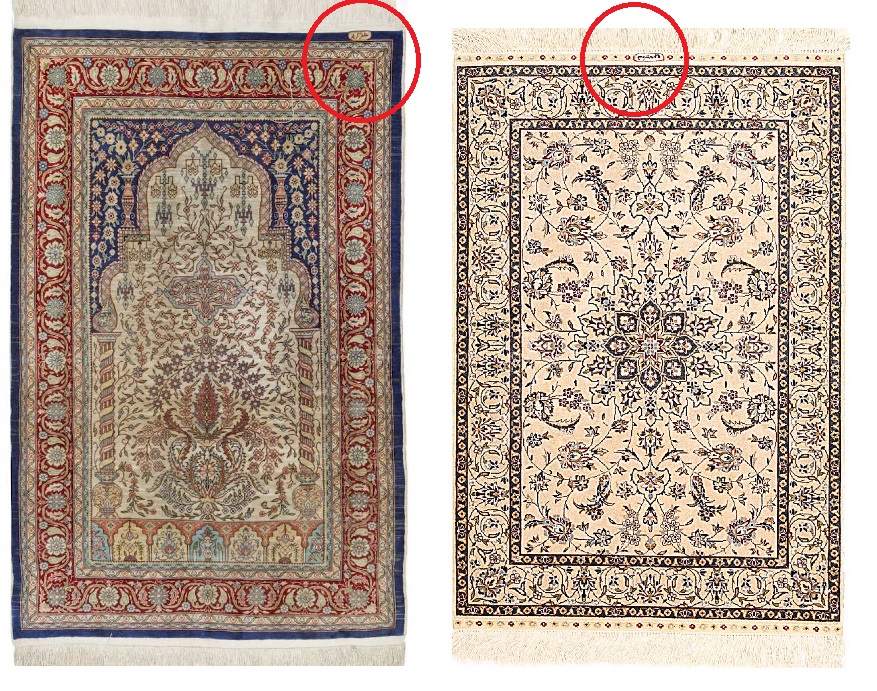

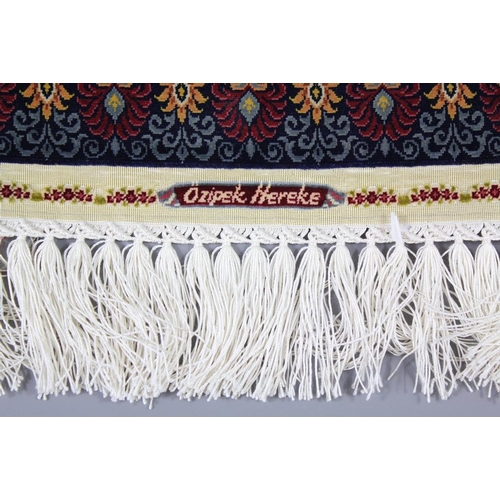

Some Hereke houses feature their names in signatures too.

Genuine versus Fake
There are a number of ways one can spot a fake and here are some:
- Genuine Hereke is a silk on silk (all natural) rug; copies are often not.
Burn a small segment of the fringe to spot fake silk
Real silk will not burn. Instead, it will smoleder slowly and then the fire will die. Use more than one thread for more reassuring results.
Artificial silk will instantly flare up and burn very quickly.
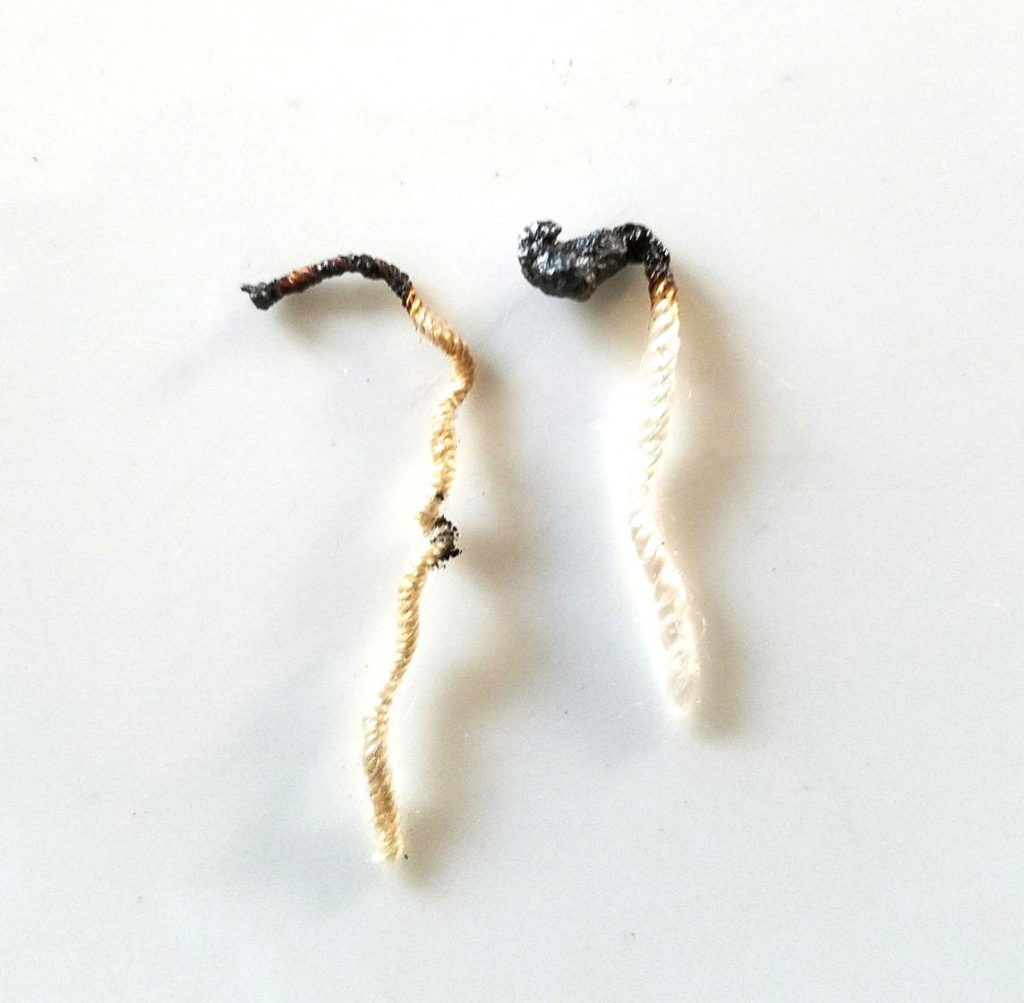
- Remember that most Herekes are signed quite discretely, only once. Some forgeries may feature more than one signature.
- Hereke rugs have very fine double-layered Turckoman-like selveges; most fakes feature simple rolled hemming sides
- Herekes will rarely feature realistic images (birds, etc); some forgeries may.
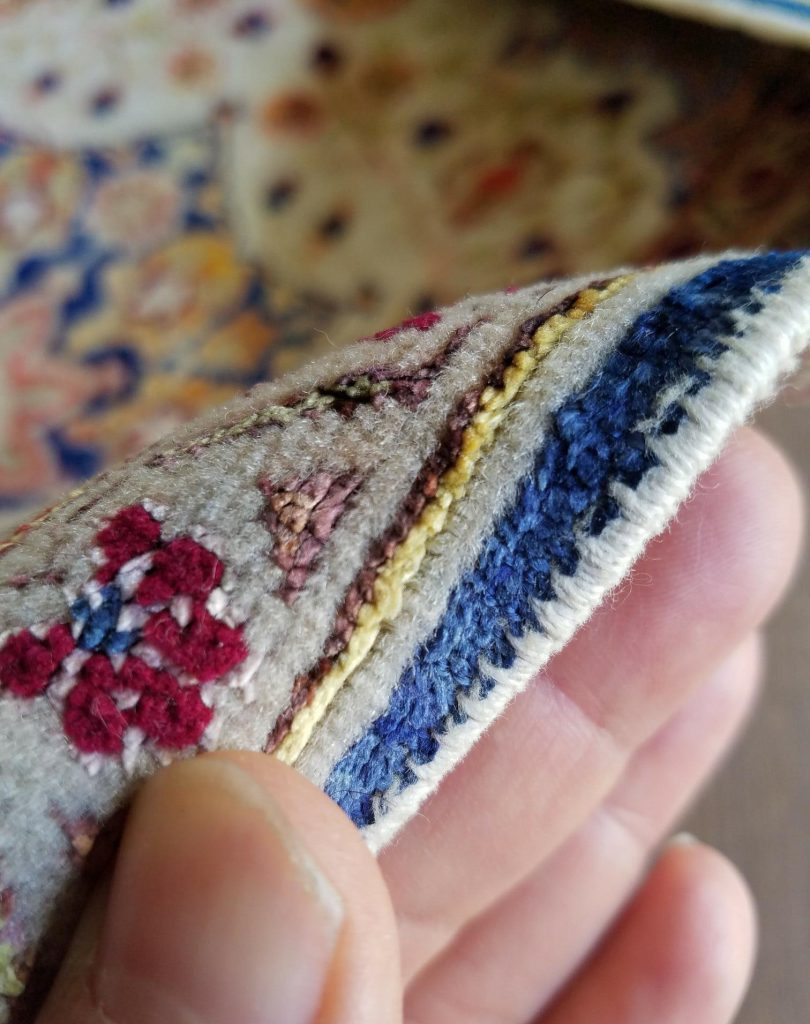
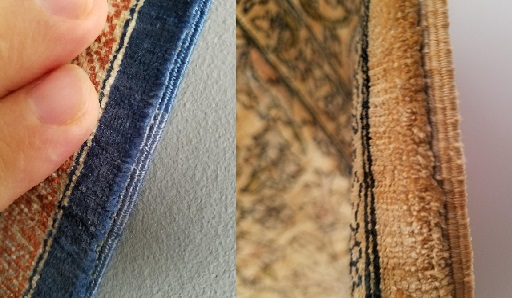
Delicate double-edge selvege finish on a Genuine Hereke rugs
All in all, when investing money in buying a silk Hereke rug, consult an expert if in doubt. If you are buying a decorative item, on the other hand, origin may not be very relevant; there are beautiful Chinese Herekes; there are beautiful Keyseris. However, buying a forgery harms the genuine industry.
A.G.
Post Scriptum
Some Herekes may display inscriptions from the Koran or Hadith

The cartouche (inscription) contains a Hadith attributed to Mohammed: ‘Those who pray shall enter the Paradise’ قال عليهم السلام من صلى البرديندخل الجنة

Excellent article, Piotr!
Thank you, Camillo. You taught me the burning trick 😉
I don’t fully agree with you because I have a 100% handmade silk rug with no avian motif and with the correct selvage. I bought it in Turkey from the actual manufacturer and it was sold as Hereke. I saw them boiling the cocoons and everything. But my rug isn’t signed. So if it’s not Chinese, and it’s not Hereke because it’s not signed, and it’s not keyseri because it’s pure silk and has Hereke selvage, then who made it?
Lastly, does the signature have to say Hereke, or can it be the name of the weaver? Is there a certain style to the signature? I see many with a yellow background, but then I see other signatures that are on the left side, or they don’t have a yellow background.
Would a Hereke have Koran passages in it? And if so, what of the rugs with mirror scripting on the rug, are those fake? Lastly, did Hereke rugs incorporate gold thread?
I have seen Hereke with short passages from the Koran. I need to find photos of one I used to own to illustrate the point. The inscriptions are commonly in ancient Ottoman Turkish and there are few people who can read them. Only some Herekes incorporate metal thread.
Not all Herekes are signed. I don’t why some weavers would not want to sign their work but I guess it may have to do with humility … Rugs such as Herekes are nor prayer rugs but expressions of adoration for God. There different styles to the signatures and t times the signature may include other words … e.g Ozipek. I used to own a Hereke that said Better Hereke … Incidentally, I was told that Better was a well-known family in Hereke so yes the signatre may include the name of the artists.
Yea I can’t guarantee if my rug is Hereke because I didn’t see it being sewn in the proper region, but I was in Turkey when I bought it from a manufacturer who showed me the boiling cauldrons of silk cocoons, I saw the room with all the weavers. Mine is 100% silk, Turkish hand knotted to a little over 400kpsi, and has paperwork that it’s Hereke, and I bought in 2001 before China really started being a problem. But it’s not signed. There is discussion that a rural weaver may not be able to read and write so they may not sign. Also, rural families may disapprove of individualism or straying too far from a family pattern. But a metropolitan rug will be signed. I bought my rug in a very rural area. It could be Keyseri which is why I disagree with this site that Keyseris all use mercerized cotton when in fact Keyseri rugs can be just as nice as a Hereke. It just depends on the materials and quality of the weaver.
All you are saying is perfectly true. Keyseri rugs are beautiful and some may be made in silk too. I have never seen one though that I can vouch for. If you love your rug that is ultimately what matters … There is an easy way to test whether a rug is real or faux silk but silk is not in any way a guarantee of a superior product …
Hello, I recently bought a rug at an estate sale and it has everything you describe pointing to the conclusion that it is a Chinese Hereke silk on silk rug (I had a it cleaned by a local rug dealer and they verified that it is silk on silk). It has the feel of a silk rug and it has the lovely double-edge selvage. The one thing that has me puzzled is that the rug is signed twice (once on the top and once on the bottom) in the kilim?
Look carefully at the selvege. The Turkish Hereke is a very fine 2 step edge similar but much finer than Turkonam rugs. The Chinese make them overcast. Please send me a photo info@ayaangallery.com I will be happy to look at your piece
My father bought a beautiful silk Hereke while visiting the town in the early 1990s. He paid quite a bit for it and it is stunning. On the label on back it does say “CH Hereke.” It was a Chinese rug imported for the unsuspecting tourist and, while it is a nice rug, it is not the real deal and worth a little over a quarter of what he paid for it. The fakery has been going on for quite a while.
YEs, sadly this is happening in Turkey with sellers importing good but substantially cheaper Chinese Herekes and selling them as the real thing to unsuspecting buyers. There are differences and this is why I felt compelled to study the subject and write this blog
Great and very informative article!
I have one question: recently I have seen many very fine Hereke silk rugs on auctions that had the signature Özipek. Later I found out that Özipek just means pure silk in turkish but still the sellers claim that Özipek is the signature of the artist or factory. Does anybody know more about this?
Ozipek is the renowned workshop , a family run one, one of the world fame. Their Herekes are typically squarish and small.
Yes, Keyseris can be beautifil and some , very few are made of silk
The vast majority of production used art silk as the material
Hi Peter, does that mean that an original Hereke pure silk carpet that is not from that workshop can’t be called Hereke Özipek, although it a Hereke öz ipek (Hereke pure Silk in turkish)?
Ozipek is one of the workshops
in the town of Hereke
I have absolutely no idea what I bought! I don’t have any paperwork. The carpet does not appear to be silk but rather cotton, perhaps mixed with wool. There is no signature. The pattern is Hereke. I have done some research so I don’t think there is any question about that. It measures about 58″ x 80″. I guess it could be a Keyseri. If I send you some photos, could you help me identify what I have? I do hope I did not buy a machine-made cheap carpet because I paid for an oriental.
Please send me the photos. Let”s have a look
Hi I bought a carpet recently in Selcuk and I’m really wondering about it. Is there a way I could send you a few pics to see what you might be able to tell me?
Yes, of course. Please send the photos. I will be happy to help
Hi,
This is an excellant article with great tips but I am still not sure if my carpet is Hereke. I bought it in 1983 in Kusadasi and yes was completely taken in by the charming guys in the shop.
But it has lots of plus points; edges, signature, silk on silk.
Would I be able to send some photos for your expert opinion please.
Many thanks.
I purchased a small silk rug at a reputable shop in Istanbul in 1999 that features the correct hem as well as the Hereke signature centered at the top of the pile area and done in a discreet light blue. It has about 21 colors including gold thread, and (if I recall correctly) about 233 kpcm. I haven’t doubted its authenticity, but the design is a non-symmetric hunt scene including many birds, trees, animals, and mounted horsemen with extraordinary detail and nuance. This seems to go against your note about typical Hereke designs. Do I have reason to be concerned about my investment in this stunning rug?
Hi Donna
I would love to see your piece. Please send me some pics. Make sure we can see the selveges; they are the indicators of authenticity
Piotr
info@ayaangallery.com
Hello. I have a few questions.
1-What time frame were silk on silk with some gold thread signed Ozipek?
2- What does it mean when a silk Hereke has the Ozipek signature ?
3- Is there someone that can read Ottaman script ? I think it is versus from the Quran?
4. Is there a way to tell how old a silk on silk Hereke is?
5-If a silk Hereke has the Ozipek signature would it be woven elsewhere?
6-Who were the weavers in Ozipek?
1 – in 1920, after the collapse of the Ottoman empire , Hereke workshop was tunred into a school. Many people who graduated from the Hereke school a few years later set up their shop. Ozipek is one such workshop. the so called Polish thread which is gold plated copper, became available as early as the late 19th century. It is called Polish thread because Polish aristocracy used to commission rugs in Iran with that thread. They were called Polonais rugs
2- It is signature of the workshop
3-I cannot but some of my friends can We will need to see pics of the script
4- It is not easy but each decade shows a diffent colour trend
5- Ozipek , unless a forged one, is made in Ozipek workshop
6- the family named Ozipek
Can Hereke rug be made in India??
The original Hereke rugs are only made in the town of Hereke near Istanbul in Turkey.
Hello, I’ve so enjoyed reading your article, very informative! We inherited a silk Hereke rug from our grandparents; they received many items as gifts from traveling friends and we are unsure of how old this rug is. It does have a signature on the center top pile. The rug overall has a sheen to it, with beautiful gold and silver threads in some areas. I wonder if I could send you a picture to get more info on it’s authenticity?
Absolutely, please send the phots to info@ayaangallery.com
Yes Please I will be happy to look at your rug
Nope/ Only in the town of Hereke. The Chinese Hereke rugs are hand made and show excellent quality. They lack imagination though
Hi Peter,
Thank you for your lovely article. There is a Turkish Bazaar in St. Thomas on the cruise ship pier. Although it obviously caters to the most touristy of tourists, we have bought some beautiful items there on a couple of occasions. They have been hit very hard by the sudden and complete disappearance of the cruise industry and are traveling around in the US, trying to unload merchandise. We bought a large silk carpet that they claimed was Turkish Hereke. They specifically named a family, Bursa, that they say produced it. It is unsigned. I wonder whether it is real, Chinese, or Keysere.
Are the Chinese Hereke carpets handmade or machine made.
Can we send pics?
Ed
Hello, some Chinese Herekes are actually well made and show higher knot density than most Herekes. They lack however imagination and appear to evoke no emotions. You can tell a Chinese Hereke (some are even signed as such) by the selvege finish which while in Turkish Hereke is a fine double-cord , it is a overcast in Chinese works
Of course, will look with pleasure
Hello Sirs,
Excellent post, very complete and informative. I only wished I had read it before travelling to turkey as I would be asking better questions. I also have some doubts about a potential 😊 Hereke silk carpet I bought. I do love the object itself, regardless of if it is Turkish or Chinese but I am curious to know the truth. Could you look at it? Thank you!
Sorry it too so long. Please send me some photos. I will be happy to help. Make sure I can see the selvege
Thank you
Piotr
Good morning,
Cant reach you by email, I get this message:
550 5.1.1 : Recipient address rejected: User unknown in virtual mailbox table
Regards
Hi. Thanks for the very interesting and informative article. Was wondering if you could have a look at a rug I got online. Just wanted to know if it is Chinese (most likely) or hopefully an authentic one. Would appreciate your expert opinion on this. Thanks!
please try peter.inadvance@gmail.com
I just purchased two rugs in Istanbul. I have since realized that there is no way that they are silk as claimed by the shop. I am actually OK with this, since I was really looking for a nice memento of my trip, and not an “investment.” The question I have is, how can I tell whether it is mercerized cotton or viscose? I suspect mercerized cotton since I was told I could throw the rug in the wash (low temperature), and this would not be advisable with viscose. My burn test looked like your burn sample on the right. And the ash crushed between my thumb and forefinger with very little pressure. No real smell (or maybe my nose isn’t working?)
By the way, I was told that the rugs were not handmade, but the fringe is definitely continuous with the rest of the rug and not “sewn on.” And the rug shows the pattern on the reverse side. I suspect woven, but on a machine?